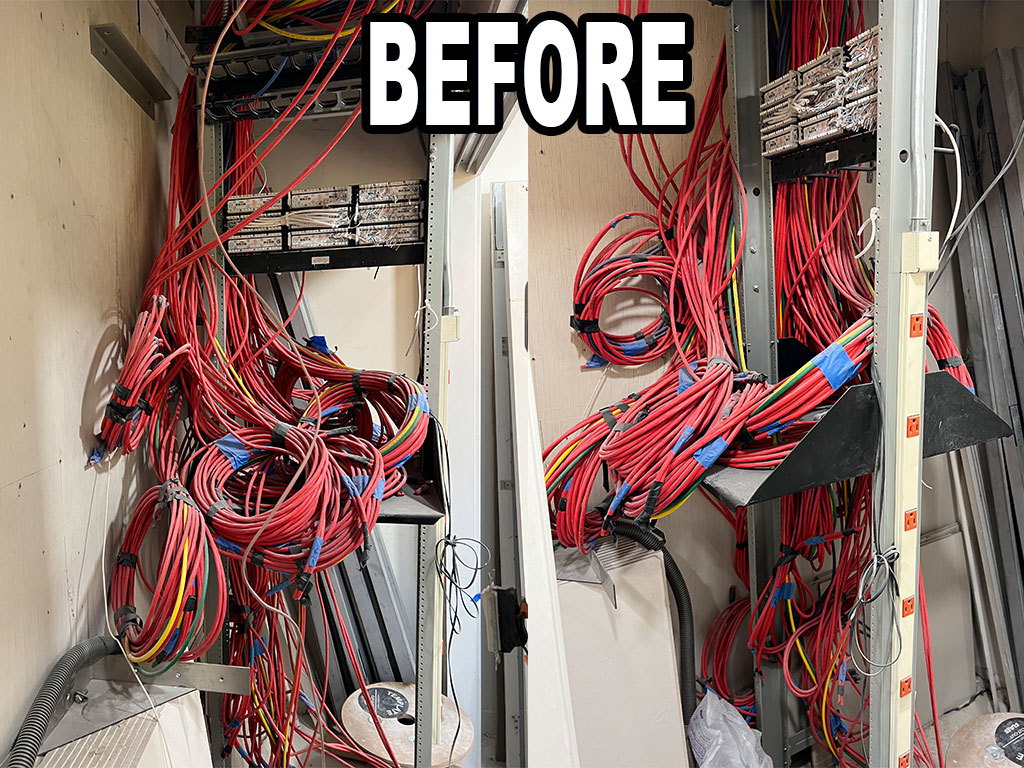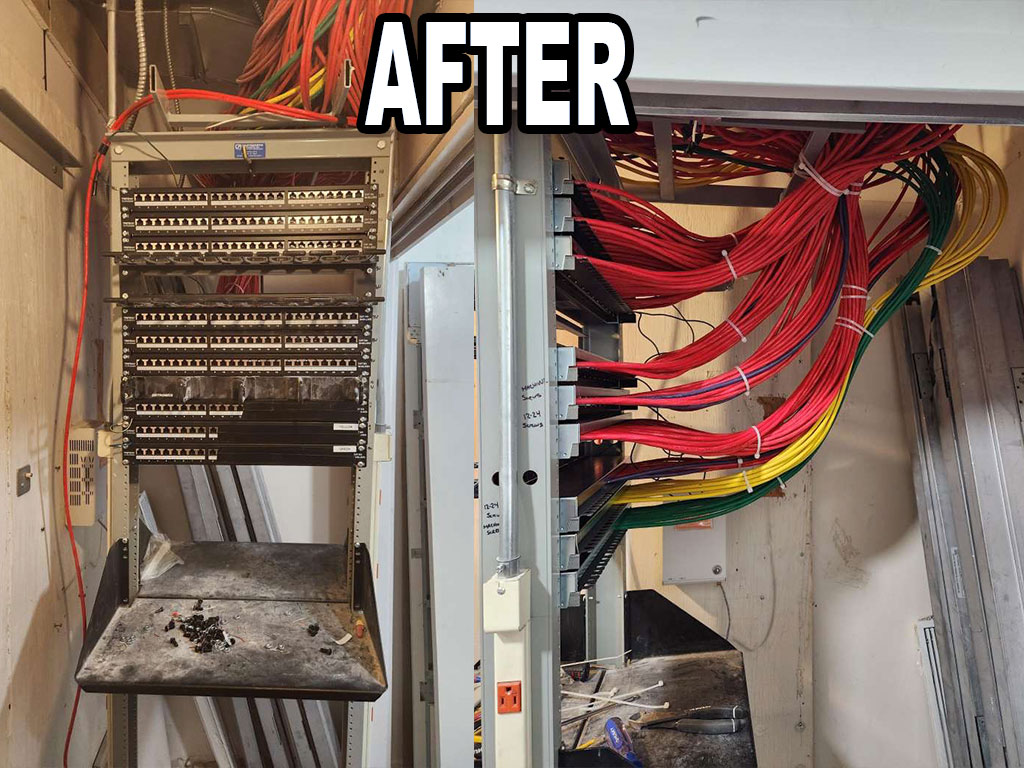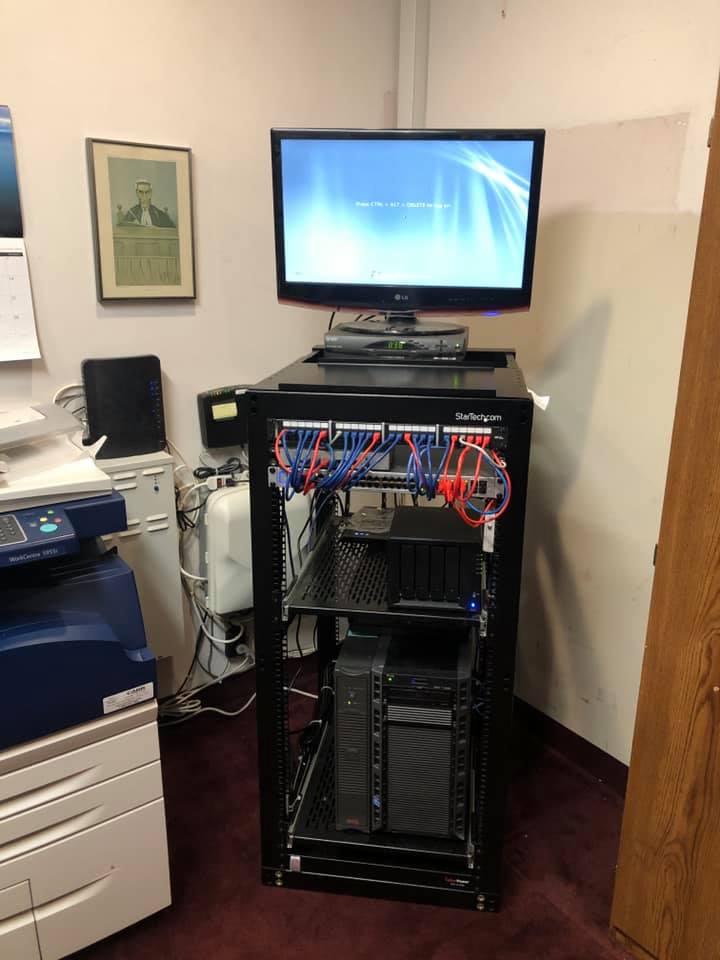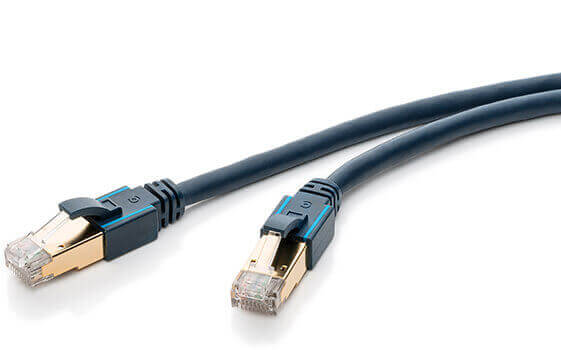Long Island Network Cabling Cat5e / 6
Our Telecom division specializes in the installation, testing, and finding of wires that are considered low voltage cabling. Low voltage wiring is one of many critical requirements for businesses to run efficiently. We are the Long Island network cabling specialists.
Common networking practices:
Networks recommends at least one data port and one telephone port next to every outlet. It’s very possible to not future-proof your facility during construction and find yourself without adequate data or telephone ports. Other network-attached devices such as printer/scanner units would also require a dedicated data jack somewhere nearby.
Cat5e Cabling
Cat5e cables are a very popular and common cable that is frequently installed as the backbone of any office environment. Using Cat5e is advantageous over other forms of internet cables as they provide the same reliable and fast data transfer speeds as any modern equivalent at a lower base cost while being easy to install and tip with a male or female jack, making them a popular choice for both residential and commercial networking needs.
Compared to older cables like Cat5, Cat5e cables have higher bandwidth capabilities, which means they can handle more data at once. Additionally, they have better resistance to cross-talk and other forms of interference than past formats of cabling, resulting in a very convenient, functional, and stable experience.
Cat5e cables are also widely available and very compatible with a variety of networking devices. The hardware that typically pairs with it are relatively inexpensive compared to more elaborate networking setups, making them an affordable option for both small and large-scale networking projects.
Cat6 Cabling
Cat6 cables offer several advantages over other internet cables, including their older cousin, Cat5e, making them a popular choice for those who require high-speed and reliable data transfer along with the added possibility of shielding inside of the cables if the shielded variant of Cat6 is chosen. These cables provide faster data speeds than their predecessors, such as Cat5 and Cat5e cables, making them ideal for demanding applications such as video streaming and online gaming.
Although internet speeds are the same as Cat5e cables at 1,000 Mbps per second, it should be highlighted that Cat6 cables also have more than double the bandwidth capacity than Cat5e cables at a formidable 250 MHz, which means they can handle more data at once without sacrificing performance. This feature makes them a top choice for businesses that require high-speed data transfer and need to transfer large
amounts of data quickly and efficiently.
Another advantage of Cat6 cables is their improved signal quality and reduced crosstalk. They use advanced insulation and twisted-pair designs to minimize interference, resulting in a more stable and consistent connection. A plastic quad shield in the center of the cable provides added separation for each twisted pair.
Cat6 cables are perfectly backward compatible with Cat5 and Cat5e cables, so they can be used in conjunction with existing similar infrastructure. This makes upgrading to Cat6 cables a simple and problem-free process for businesses and home-users.
Overall, if you need a high-speed, reliable, and future-proof networking solution, Cat6 cables are an excellent choice. They offer superior performance and signal quality, making them the go-to choice for demanding applications and businesses that require high-speed data transfer.
Cat6a Cabling
Cat6a cables offer a range of major advantages and improvements over its predecessors, making them a preferred choice for requiring significantly higher-speed and reliable data transfers than other environments may. These cables are capable of providing much faster data transfer speeds than their older variants, such as Cat5, Cat5e, and even Cat6 cables, making them ideal for demanding applications such as intense online gaming sessions, video streaming, and of course, data center applications.
Cat6a cables have a far higher bandwidth capacity than Cat6 cables, operating at 500 MHz compared to the 250 MHz of Cat6 cables, which means they can handle even more data at once without sacrificing performance. This feature makes them ideal for businesses that require ultra-fast data transfer and need to transfer large amounts of data quickly and efficiently. They have also received significant improvements in their maximum speed. Whereas Cat6 has a transfer speed of 1,000 Mbps, Cat6a has a maximum transfer speed of 10,000 Mbps under ideal conditions. Keep in mind that there will always be a “weakest link in the chain” slowing file transfer speeds down, and those are typically found in the router or workstations themselves.
Another significant advantage of Cat6a cables is their improved signal quality and reduced crosstalk. They use advanced shielding techniques within the cable to minimize interference, resulting in a more stable and consistent connection. This feature is particularly critical in high-density environments such as data centers, where there are a large number of devices competing for bandwidth.
Additionally, although Cat6a cables have the same maximum recommended cable length as other Cat5e or Cat6 cables, their shielded nature allows them to deliver the same quality of packets down the line until it reaches the 100 meters or 328 feet range. If you require longer runs than that, please consider using a repeater or getting a network switch to bridge the runs.
Overall, if you require a high-speed, reliable, and future-proof networking solution, Cat6a cables are an excellent choice. They offer superior performance and signal quality, making them the go-to choice for demanding applications, data centers, and businesses that require ultra-fast data transfer.
Patch Panel
We recommend one or more patch panel to help organize those wires for you in a meaningful and productive way. It facilitates an easier and speedier troubleshooting process in case of future hardware issues, as well as just making it look nice.
Terminating Your Wiring or Existing Cabling
We will only terminate wires to female jacks, male crimp plugs, a patch panel, coupler, and punch down splicing boxes. We avoid using electrical tape to terminate our wiring, as it is very sloppy work that anyone can do. It’s not meant to be a permanent fix. If and when we have to terminate wires using electrical tape, it will only be used temporarily until a permanent solution is found and the cabling situation resolved, or if someone’s life is at stake. Otherwise our technicians take their time to terminate the wire correctly.

PROFESSIONAL LONG ISLAND NETWORK CABLING, TROUBLESHOOTING & CONSULTING
Specializing in Long Island Network Cabling


Long Island's Cat5e Cat6 Cat6a Network Cabling

How does my VOIP Phone system effect my computer network? –If you have 1 or two phones tops then you will not have too much problems, if is when you have two or more phones that is when problems arise. VOIP phone system is a LAN Line phone that requires an active Internet Connection from your Internet Service Provider like: Verizon, Time Warner, Cablevision, At&t, etc. These VOIP Phones usually gets connected in-between your computer/device and router/networking switch. Since these VOIP phones are connected this way, they will slow down your internet speed going to the computer/device and can cause corruption to data files over your computer network. The more phones and/or activity with these phones, the more damage can occur. If you still want to continue using the VOIP Phone System, then Networks, will recommend a proposal to split your VOIP phone system from your computer network, by preventing corruption that may occur, to slowness in transferring files over the network. By splitting your VOIP phone system from your computers is not hard at all, it will require additional wiring only for the phones and additional routers to break up the VOIP Phone System Network from the computer network. If your VOIP phone system is slowing down your internet speed even after the splitting of the devices, then you might have to upgrade your Internet Server Provider bandwidth speed to be able to handle a better connection.
List of types of Low Voltage wiring but not limited to:
- Cat 3/5/5e/6/7 – Telephone / Computer Data Wire
- PE89 – 12 Pair Telephone Wire
- HDMI Wire
- RCA wire
- Video Component Wire
- RG-59/RG-6 – Coax (TV) Wire and DVR Surveillance
- Speaker Wire
- S-video Wire
- DVI computer Wire
- D-sub – standard Monitor Wire
- RS-232 Serial / USB Wire
- Fibre Optic Wire

